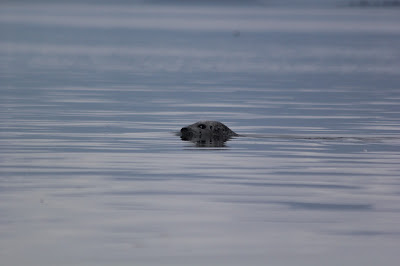Figuring out the loudness at which an animal is vocalizing
is a deceivingly difficult question to answer.
To investigate this question of loudness, we use an equation that, on
the surface, is deceivingly simple – the sonar equation.
SL = RL + TL
Source level (the actual loudness of the call) is equal to
the received level (the loudness of the call when it gets to the hydrophone)
plus the transmission loss (the amount of loudness that’s lost over the
distance between the caller and the hydrophone). How bad could it be?
Calculating received levels – this involves a few pieces of
information. First, you need to know
when your animal is actually vocalizing.
I’ve browsed through dozens of hours of acoustic data from the 2015
season and have marked hundreds of calls from harbor seal males. Lucky for me harbor seals call almost
nonstop; at least finding the calls is easy enough. I also need to know some information about my
hydrophone, mainly the sensitivity.
Different hydrophones have different sensitivity levels, which
influences the calls it can pick up. A
more sensitive hydrophone can pick up quieter calls than a less sensitive
hydrophone. Then, after I’ve input these
hydrophone parameters, with the flick of my magic acoustic wand, a program
called Raven will give me a received level.
Step one is complete.
 |
| Pretty picture from Strawberry Island to break from the scienceness of this blog post (Photo: L. Matthews) |
Transmission loss is a bit more of a beast. Back in the 1980’s, Malme and Miles came to
Glacier Bay and investigated how sound travels underwater in this
environment. Turns out that sound
attenuates at a rate of 15log(r), where r is the distance from the vocalizing
animal to the hydrophone. So if I want
to quantify how much loudness is lost between my animal and my array, I need to
know from where my animal is calling.
Enter acoustic localization.
Sound is a pressure wave traveling through a medium. In water, sound travels approximately 1500
m/s. Depending on where an animal is
located when it calls, the vocalization will travel through the water and
arrive on the different hydrophones in our hydrophone array at different
times. The call will get to the closest
hydrophone first, and the farthest hydrophone last. You can see what I mean in the spectrogram
below. Each line is a different
hydrophone, and this particular calling animal is closest to the second
hydrophone.
I am lucky enough to be collaborating with a group at
Cornell University called the Bioacoustics Research Program. They’re the ones who make the software that I
use to do the acoustic localization.
It’s been an up and down process to get this localization up and
running, but after a few rounds of troubleshooting, it’s working with a fair
amount of consistency. It’s a slow and
time-consuming part of calculating source levels, but so far I’ve managed to
locate over 250 harbor seal vocalizations.
 |
| Harbor seals called here. |
Then there’s some coding involved to get the actual
distances between the caller and the hydrophone, and a little excel spreadsheet
organizing, but then it’s just plugging and chugging to get a number for a
source level. Sweet science
victory.
 |
| Hello sweet angel. (Photo: L. Matthews) |
I’ve always been intimidated by calculating source levels,
and rightfully so. There are a lot of
different pieces that have to fall into place for everything to turn out
correctly. In my downtime on Strawberry
Island, I’ve been slowly but surely chipping away at my source level
analysis. The island seems to be a good
place to hunker down and focus. Somehow
it’s so much easier to be on my computer and not get distracted when the
internet is just a distant memory….
 |
| Working hard on the beach. |
Now that I’m getting baseline estimates of how loud harbor
seals are vocalizing, I can start to answer another question. Do harbor seals change their source levels
when there are vessels nearby? We see
this phenomenon in many species, including humans. When our environment is loud, we get louder
so that other people can hear us. I’m
curious to see if harbor seals do the same thing.
 |
| Cruise ships are a regular occurrence during the summer (Photo: L. Matthews) |
FUN SCIENCE FACT #36: Sound travels almost 5x faster underwater compared to in air. From the hydrophones, we can hear a cruise ship coming almost 45 minutes before it gets to the island.










